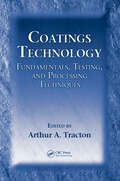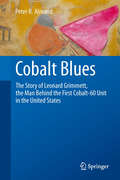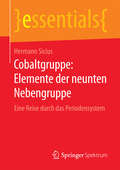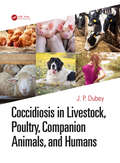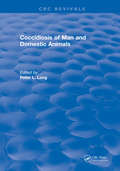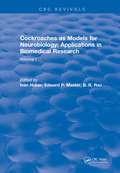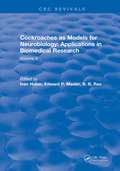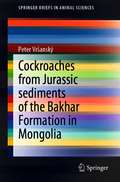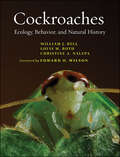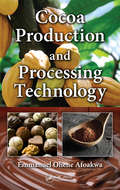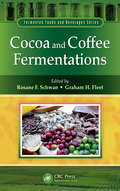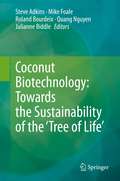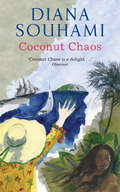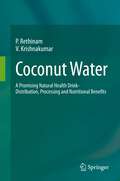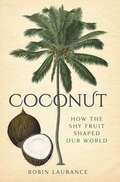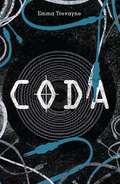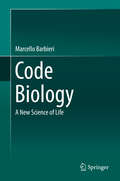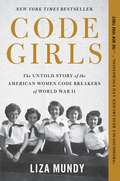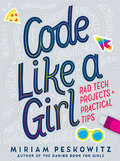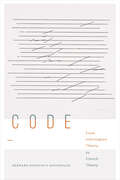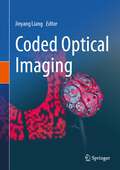- Table View
- List View
Coatings Technology: Fundamentals, Testing, and Processing Techniques
by Arthur A. TractonDrawn from the third edition of The Coatings Technology Handbook, this book focuses entirely on testing, experimental design, and strategies for selecting processing techniques in the coatings, adhesives, paints, and inks industries. Coatings Technology: Fundamentals, Testing, and Processing Techniques contains the latest coating and processing met
Cobalt Blues: The Story of Leonard Grimmett, the Man Behind the First Cobalt-60 Unit in the United States
by Peter R. AlmondFor the last half of the 20th century cobalt-60 units were the mainstay of radiation treatments for cancer. This book describes the development of the first cobalt -60 unit in the United States and the man behind it, Leonard Grimmett. Conceptually conceived before World War II it only became possible because of the development of nuclear reactors during the war. The initial idea was to replace the radium in the contemporary units of the time with cobalt-60, but with the realization that the reactors could produce much more cobalt-60 than originally thought the design of the cobalt-60 unit was drastically changed to take advantage that the application of the inverse square law to cancer radiation treatments would make. Although Grimmett conceived of and published his ideas first, the Canadians built the first units because of the capability of their reactor to produce more suitable cobalt-60 sources. The story tells how Grimmett and the other people involved came together at the time that the U S Atomic Energy Agency was pushing the use of radioactivity in medicine. But Grimmett died suddenly before his unit could be built and very little information about him was known until recently when various documents have come to light, allowing the full story to be told.
Cobaltgruppe: Eine Reise durch das Periodensystem (essentials)
by Hermann SiciusHermann Sicius stellt ausf#65533;hrlich die Elemente der neunten Nebengruppe (Cobalt, Rhodium, Iridium und Meitnerium) vor, deren physikalische und chemische Eigenschaften relativ #65533;hnlich sind. Cobalt wurde 1735 entdeckt, Rhodium und Iridium Anfang des 19. Jahrhunderts. Auch beim Elementenpaar Rhodium und Iridium ist noch die Auswirkung der Lanthanoidenkontraktion zu beobachten. Die jeweiligen physikalischen Eigenschaften dieser zwei Elemente unterscheiden sich jedoch schon merklich, nicht aber die chemischen. Die Eigenschaften des Cobalts dagegen weichen von denen der zwei ,,edlen" Platinmetalle Rhodium und Iridium deutlich ab, so zeigt Cobalt ein negatives Normalpotential sowie niedrigere Dichten, Schmelz- und Siedepunkte. Bei Cobalt ist aber die Oxidationsstufe +2 die stabilste, bei Rhodium +3 und bei Iridium +4. K#65533;rzlich gelang jedoch die Erzeugung von Iridium-VIII- und IX-Verbindungen. 1982 konnten die ersten Atome des Meitneriums erzeugt werden.
Coccidiosis in Livestock, Poultry, Companion Animals, and Humans
by J. P. DubeyCoccidiosis is one of the most important diseases of livestock, particularly poultry, with billions of dollars spent on prevention worldwide. The disease is so important and pervasive that until recently, all poultry feed was medicated with coccidiostats, mainly antibiotics. With the rapid development of drug resistance, the search is on for alternative methods of control of coccidiosis in poultry. With chapters authored by internationally renowned scientists, this book covers coccidiosis in all major livestock species, including cattle, sheep, and goats. Special emphasis is given to poultry coccidiosis given the significant economic impact, and another chapter looks at intestinal coccidiosis in humans, including Cyclospora. Chapters discuss techniques, molecular biology, host-pathogen immunobiology and immunoprophylaxis, genetics and genomics, biology, and chemotherapy. Despite an explosion of research in the last 40 years, there has been no new book published discussing conventional coccidiosis for more than 25 years. This comprehensive review therefore answers an urgent need for a book dealing exclusively with conventional coccidia (Cystoisospora, Cyclospora). It provides concise, authoritative, up-to-date information on coccidiosis, with particular attention given to research in the last 28 years. This book is essential reading for any practitioner or researcher involved in livestock production, including biologists, veterinarians, parasitologists, and researchers from government, academia, and industry.
Coccidiosis of Man and Domestic Animals
by Peter L. LongThe present book deals with the biology of a wide range of coccidia of numerous genera including Emeria, Isospora, Sarcocystis, Toxoplasma, Caryospora, and Cryptosporidium. The book will be valuable for advanced undergraduates, graduate students, research workers, and teachers in biology, especially useful for parasitologists teaching the subject and essential for coccidiologists doing research on coccidia. The book has also an appeal for physicians, veterinarians, and zoologists needing an update of information in the general field of coccidiosis
Cockroach Robots (Environments and Survival)
by Chloë Delafield Ari KrakowskiNIMAC-sourced textbook
Cockroaches as Models for Neurobiology: Volume I
by Ivan HuberThis unique book is written with the novice in mind, providing an introduction to all aspects of working with cockroaches. The focus of this writing is on the neuroendocrine system of cockroaches, which was collected by entomologists, primarily with the aim of improving methods of insect pest control. It includes some chapters devoted exclusively to techniques with detailed instructions. This comprehensive work also covers details of anatomy along with illustrations and experimental results. This is one of the few books available which provides such a broad coverage of areas of neurobiology of one organism. This handbook is a must for all researchers in the biomedical/veterinary field. Entomologists will find this reading exciting as well.
Cockroaches as Models for Neurobiology: Volume II
by Ivan HuberCockroaches offer a useful and inexpensive alternative to traditional laboratory animals, yet most researchers are unfamiliar with their biology. This unique and comprehensive cockroach handbook is written for everyone from novice to expert. It addresses every aspect of cockroach biology, with a particular emphasis on the neuroendocrine system. Liberally illustrated chapters include such topics as cockroach culture, anatomy, behavior, and various experimental techniques. One of the few available books to provide broad coverage of the neurobiology of a single organism, this second volume is a must for all researchers in biomedical or veterinary fields, as well as for entomologists.
Cockroaches from Jurassic sediments of the Bakhar Formation in Mongolia (SpringerBriefs in Animal Sciences)
by Peter VršanskýThis book provides essential information on 12 cockroach assemblages with more than a thousand specimens analyzed and investigates the Jurassic site in Bakhar, Mongolia, as one of the most diverse fossil insect sites worldwide. The findings presented here include 32 new cockroach species (of a total of 300 Jurassic species described worldwide). Since several individuals of each species are investigated, the book is the first that contains information on the variability of an Upper Jurassic organism. The wings of the cockroach specimen only rarely show wing deformations, suggesting that the ecological conditions at Bakhar were optimal during that time. The book’s content is clearly structured, moving from collection methods, to phylogenetic analyses, to a comparison of global fossil sites. Given its scope, the book appeals to all (Jurassic) paleontologists, botanists and paleoentomologists, as it offers an unbiased counterpart to the extensively studied Daohugou site in China. It is also useful in the mining industry, as the strata contain strategic coal (and other materials).
Cockroaches: Ecology, Behavior, and Natural History
by William J. Bell Louis M. Roth Christine A. NalepaThe essential volume on cockroach biology and behavior.The cockroach is truly an evolutionary wonder. This definitive volume provides a complete overview of suborder Blattaria, highlighting the diversity of these amazing insects in their natural environments. Beginning with a foreword by Edward O. Wilson, the book explores the fascinating natural history and behavior of cockroaches, describing their various colors, sizes, and shapes, as well as how they move on land, in water, and through the air. In addition to habitat use, diet, reproduction, and behavior, Cockroaches covers aspects of cockroach biology, such as the relationship between cockroaches and microbes, termites as social cockroaches, and the ecological impact of the suborder. With over 100 illustrations, an expanded glossary, and an invaluable set of references, this work is destined to become the classic book on the Blattaria. Students and research entomologists can mine each chapter for new ideas, new perspectives, and new directions for future study.
Cockroaches: Ecology, Behavior, and Natural History
by William J. Bell Louis M. Roth Christine A. NalepaThe essential volume on the biology and behavior of these remarkable insects. “This transformative work will be an inspiration to students of entomology.” —ChoiceThe cockroach is truly an evolutionary wonder. This definitive volume provides a complete overview of suborder Blattaria, highlighting the diversity of these amazing insects in their natural environments. Beginning with a foreword by Edward O. Wilson, the book explores the fascinating natural history and behavior of cockroaches, describing their various colors, sizes, and shapes, as well as how they move on land, in water, and through the air. In addition to habitat use, diet, reproduction, and behavior, Cockroaches covers aspects of cockroach biology, such as the relationship between cockroaches and microbes, termites as social cockroaches, and the ecological impact of the suborder.With over 100 illustrations, an expanded glossary, and an invaluable set of references, this work is destined to become the classic book on the Blattaria. Students and research entomologists can mine each chapter for new ideas, new perspectives, and new directions for future study.“Well-written . . . visually attractive . . . This book is much needed to educate biologists about the fascinating biology and diversity of cockroaches.” —Integrative and Comparative Biology“A must-have for any insect hobbyest.” —Allpet Roaches Forum“This contribution is an important source of information on cockroach natural history and diversity.” —The Quarterly Review of Biology“Suitable for researchers, students, and naturalists, chapters are topical, exploring the diversity of cockroaches.” —Southeastern Naturalist
Cocoa Production and Processing Technology
by Emmanuel Ohene AfoakwaThis book presents detailed explanations of technologies for sustainable production of high-quality and safe cocoa beans for the global confectionary industry. It describes up-to-date technologies and approaches to modern cocoa production practices, global production and consumption trends as well as principles of cocoa processing and chocolate manufacture. It covers the origin, history and taxonomy of cocoa, and examines the fairtrade and organic cocoa industries. The chapters provide in-depth coverage of cocoa cultivation, harvesting and post-harvest treatments, genotypic variations, fermentation techniques, drying, storage and transportation.
Cocoa and Coffee Fermentations (Fermented Foods and Beverages Series)
by Graham H. Fleet Rosane F. SchwanThis is the first book to focus on the scientific principles underlying the fermentation processes of cocoa and coffee beans and their impact on product quality and safety. The text compiles the knowledge from the different disciplines involved in fermentation, including botany, chemistry, microbiology, biochemistry, food science, and sensory science. The chapters discuss the botanics of the beans; fermentation methods; the microbiology of fermentation; the biochemistry and physiology of fermentation; the impacts of fermentation on bean flavor, quality, and safety; chocolate and coffee derived from the beans; and the processing of waste materials.
Coconut Biotechnology: Towards the Sustainability of the ‘Tree of Life’
by Steve Adkins Mike Foale Roland Bourdeix Quang Nguyen Julianne BiddleWidely known as the ‘tree of life’, coconut (Cocos nucifera L.) provides a bountiful source for making a wide variety of healthy foods and industrial items. Its cultivation, however, has been encountering seriously destructive issues including lethal diseases and natural adversities which are currently distressing livelihoods of millions of small-holder farmers around the world. There is an urgent mandate to resolve these issues by meeting sustainable seedling production, facilitating genetic conservation, as well as developing disease identification and modern breeding. This book introduces improvements in coconut biotechnology by covering the advances in micropropagation, germplasm conservation, and molecular pathogenic diagnosis. This comprehensive volume will be a useful source of information and references to researchers, graduate students, agricultural developers, and scholars in the plant sciences. In order to benefit general readers, the book also covers fundamental aspects of biology, diversity, and evolution of this marvelous palm species.
Coconut Chaos: Pitcairn, Mutiny And A Seduction At Sea
by Diana SouhamiAt dawn on 27 April 1789 Fletcher Christian, master's mate on HMS Bounty, took a coconut to quench his thirst from the supply on the quarterdeck. This seemingly insignificant act resulted in mutiny, chaos and a chain of events that leads right up to the present day. With a story driven by hazardous and extraordinary sea voyages and a cast that includes the Bounty mutineers, an eccentric lesbian aristocrat, Pitcairn Island sex offenders and the narrator's ancient mother, this sparkling and original book weaves together fact and fiction, history and autobiography, humour and danger in inimitable style.
Coconut Water: A Promising Natural Health Drink-Distribution, Processing and Nutritional Benefits
by V. Krishnakumar P. RethinamCoconut water, a naturally-canned tropical beverage, has been gaining popularity in recent years and has drawn the attention world over as a natural and nutritional wellness beverage. The research published thus far on coconut water has mainly focused on its specific uses, biochemical composition and health benefits as well as processing and preservation techniques and has been published mostly in journal articles. Only a few books covering a wide spectrum of coconut water for health and wellness are currently available. This work offers a comprehensive and fully updated overview of coconut water from processing techniques to value addition to safety to nutritional benefits and beyond. Coconut Water: Processing, Distribution & Nutritional Benefits provides in-depth details on all of the major processing techniques required to produce and maintain a quality product free of contamination and adulteration. The book covers the standards of coconut water production and distribution in various countries enabling the processors and exporters to manufacture and export for better revenue realization. The book also provides details of patents related to coconut water granted to researchers. Another important aspect of this work is comprehensive coverage on the various nutritional and health benefits of coconut water consumption as well as on the value addition (traditional and innovative products). In markets across the world, consumers of all ages have been turning to coconut water for its taste and nutritional benefits. This book will provide researchers, processors and exporters the comprehensive information needed to produce and market quality, nutritional coconut water for consumers.
Coconut: How the Shy Fruit Shaped our World
by Robin LauranceCoconuts have been around for longer than Homo sapiens; they have been turned into art, taken part in religious rituals and been a sign of wealth and success. They have saved lives, not only by providing nourishment, but also as part of the charcoal filers in First World War gas masks. It was coconuts that triggered the mutiny on the Bounty, and coconuts that saved the life of the man who went on to become the 35th President of the United States. The coconut has long been the unseen player in the endeavours of industrialists and bomb makers, physicians and silversmiths, smugglers and snake charmers. To this day, coconuts shape the lives of people around the world. At a time when coconut products crowd the shelves of supermarkets, health food shops and beauty salons, Robin Laurance looks beyond the oils and health drinks to uncover the unexpected, often surprising, and vital roles played by the coconut palm and its nut in times past and present.
Coda
by Emma TrevayneRevolution sings in the air when a teenage boy plays illegal, underground music in a dystopian, Corp-controlled world.
Code Biology: A New Science of Life
by Marcello BarbieriThis book is the study of all codes of life with the standard methods of science. The genetic code and the codes of culture have been known for a long time and represent the historical foundation of this book. What is really new in this field is the study of all codes that came after the genetic code and before the codes of culture. The existence of these organic codes, however, is not only a major experimental fact. It is one of those facts that have extraordinary theoretical implications. The first is that most events of macroevolution were associated with the origin of new organic codes, and this gives us a completely new reconstruction of the history of life. The second implication is that codes involve meaning and we need therefore to introduce in biology not only the concept of information but also the concept of biological meaning. The third theoretical implication comes from the fact that the organic codes have been highly conserved in evolution, which means that they are the greatest invariants of life. The study of the organic codes, in short, is bringing to light new mechanisms that have operated in the history of life and new fundamental concepts in biology.
Code Girls: The Untold Story of the American Women Code Breakers of World War II
by Liza MundyThe award-winning New York Times bestseller about the American women who secretly served as codebreakers during World War II--a "prodigiously researched and engrossing" (New York Times) book that "shines a light on a hidden chapter of American history" (Denver Post).Recruited by the U.S. Army and Navy from small towns and elite colleges, more than ten thousand women served as codebreakers during World War II. While their brothers and boyfriends took up arms, these women moved to Washington and learned the meticulous work of code-breaking. Their efforts shortened the war, saved countless lives, and gave them access to careers previously denied to them. A strict vow of secrecy nearly erased their efforts from history; now, through dazzling research and interviews with surviving code girls, bestselling author Liza Mundy brings to life this riveting and vital story of American courage, service, and scientific accomplishment.
Code Like a Girl: Rad Tech Projects And Practical Tips
by Miriam PeskowitzWelcome to Code Like a Girl, where you'll get started on the adventure of coding with cool projects and step-by-step tips, from the co-author of the bestselling The Daring Book for Girls.Coding is about creativity, self-expression, and telling your story. It's solving problems and being curious, building things, making the world a better place, and creating a future. It's about you: whoever you are, wherever you're at, whatever you want. Nearly everything you encounter on a screen is made from code. You see, with code you can have an idea and put it into action: it's your voice and your vision. From the outside, tech and code may seem puzzling and mysterious, but when you get through the door and past the first few beginner steps and your code starts to work, it feels like magic. <P><P>In this book, you'll learn how to: <li> Code with Scratch <li> projects like making a dog walk through the park, sending your friend a card, and devising a full-scoring game! <li> Build your own computer--really! <li> Create your own digital fortune-teller, with the Python language. <li> Make your own smartphone gloves. <li> Make light-up bracelets. <li> Code a motion sensor that tells you when someone enters your room. <li> And lots more!
Code as Creative Medium: A Handbook for Computational Art and Design
by Golan Levin Tega BrainAn essential guide for teaching and learning computational art and design: exercises, assignments, interviews, and more than 170 illustrations of creative work.This book is an essential resource for art educators and practitioners who want to explore code as a creative medium, and serves as a guide for computer scientists transitioning from STEM to STEAM in their syllabi or practice. It provides a collection of classic creative coding prompts and assignments, accompanied by annotated examples of both classic and contemporary projects, and more than 170 illustrations of creative work, and features a set of interviews with leading educators. Picking up where standard programming guides leave off, the authors highlight alternative programming pedagogies suitable for the art- and design-oriented classroom, including teaching approaches, resources, and community support structures.
Code: From Information Theory to French Theory (Sign, Storage, Transmission)
by Bernard Dionysius GeogheganIn Code Bernard Dionysius Geoghegan reconstructs how Progressive Era technocracy as well as crises of industrial democracy and colonialism shaped early accounts of cybernetics and digital media by theorists including Norbert Wiener, Warren Weaver, Margaret Mead, Gregory Bateson, Claude Lévi-Strauss, Roman Jakobson, Jacques Lacan, Roland Barthes, and Luce Irigaray. His analysis casts light on how media-practical research forged common epistemic cause in programs that stretched from 1930s interwar computing at MIT and eugenics to the proliferation of seminars and laboratories in 1960s Paris. This mobilization ushered forth new fields of study such as structural anthropology, family therapy, and literary semiology while forming enduring intellectual affinities between the humanities and informatics. With Code, Geoghegan offers a new history of French theory and the digital humanities as transcontinental and political endeavors linking interwar colonial ethnography in Dutch Bali to French sciences in the throes of Cold War-era decolonization and modernization.
Coded Optical Imaging
by Jinyang LiangThis book provides a comprehensive survey of coded optical imaging. Illustrated with 386 figures, it takes readers from the fundamental concepts and theories to the latest research and applications in this field. It can be used in graduate-level courses in optics and photonics. It can also benefit scientists and engineers in optical imaging, computer graphics, and other related disciplines. This book starts from a brief history of coded optical imaging and key operations in its data acquisition and image reconstruction. It then presents the latest progress in technological development and applications in the areas of biomedicine, materials science, industrial inspection, optical physics, imaging science, information theory, and more. Chapters describe the most representative techniques, exposing readers to key research themes, including: · Optical signal encoding · Image reconstruction techniques · Compressed sensing · Artificial intelligence · Metasurface · Structured light · Lensless imaging · Holography · Tomography · Light-field imaging · Utrafast imaging · Hyperspectral imaging · Polarization imaging · Super-resolution imaging
